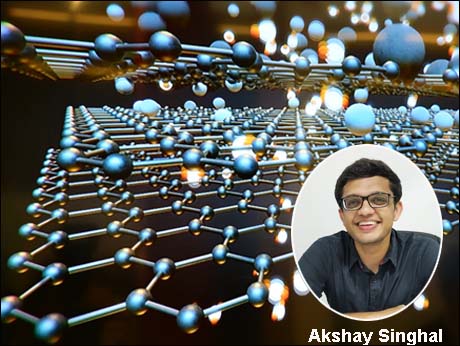
By Akshay Singhal, Founder & CEO, Log 9 Materials
April 1 2019: Energy storage devices market has been one of the most sought after segment in terms of new technological advances and capital expenditure for R&D. Breakthrough developments in this field will impact a variety of segments from small portable electronic devices such as mobile phones to the electric vehicle market. Traditional devices are limited to functionality in terms of fast charging and degradation in performance with increased charging cycles. Current energy storage devices also heavily depend on non-biodegradable materials, and hence their disposal will be a grave concern in the coming years. Graphene based metal-air batteries and Supercapacitors, otherwise known as ultra-capacitors, are few of the promising technologies that is set to revolutionize this market by addressing some of the cost and environmental concerns.
Graphene is a single layer of graphite; an array of carbon atoms arranged in a hexagonal honeycomb lattice. It is a 2D material which is 6 times lighter than steel and carries electrons at 1 million metres per second. Capabilities of this material will transform the energy storage devices with several new features, such as smaller capacitors, flexible and rollable devices, transparent batteries, and high-capacity and fast-charging devices. 1 gram of this material has a very high surface area of 2630m² and hence it has the potential to radically improve the performance of energy storage devices. This will greatly propel technology that will create smartphones that charge in seconds, and cars that can refuel in few minutes.
Metal-air batteries, fuel cells and other energy storage and conversion applications rely on efficient catalysts to sustain the chemical reactions to produce current. Precious metals including platinum, palladium and iridium have proven to be efficient catalysts, but their high cost and poor stability and durability make them unreasonable for large-scale commercialization. Research has shown that graphene based electrodes can largely reduce the dependency on precious and rare earth metals. Since graphene is an allotrope of carbon, the material is environmental friendly, safer and more stable than the volatile compounds found in lithium-ion batteries, and can function in rain, extreme temperatures and other harsh conditions. And since it replaces the precious metals, Graphene based metal-air batteries and fuel cells will make battery technology more economically viable. Graphene can be easily processed into various forms suitable for both the positive and negative electrodes, enabling the fabrication of a battery with an ultrahigh energy density. Li-Ion batteries are based on rare-earth metals and contains electrolytes which are not biodegradable and can end up in landfill after two years.
The market for graphene batteries is predicted to reach $115 million by 2022. A number of companies are already working in making this a practical reality. A Chinese company has announced a graphene supercapacitor with the capacity of a typical laptop battery that could charge up in 15 minutes, instead of a few hours. Some graphene based batteries have been developed for electric bicycles and motorcycles can be charged 12 times faster than lithium-ion batteries. Graphene derivatives are increasingly being used at production scale. Companies are working on improved manufacturing practices that can bring graphene based metal-air batteries from high-end sectors to the mass market.
Despite these technological breakthroughs, effective integration of graphene-based energy generation and storage modules into devices used in daily life as reliable and independent power sources have not received much attention. Research must focus on the stability of these smart energy storage devices and their compatibility with existing power-consuming electronic devices. This would significantly attract the attention of the masses and in turn create a demand for further improvement in the economic viability of the technology. Given the nascent stage of the material, its characteristics have not yet been fully taken advantage of and significant improvements are expected in the near future. Graphene, the wonder material has the potential to completely change our day to day life.
Log 9 Materials is a nanotechnology company based in Bangalore with a determined team of scientists and engineers working on commercializing Graphene.